How Long Does it Take For Sod to Take Root?
To establish a lush lawn, there are two options to choose: seeding grass or laying sod. While laying sod provides an immediate lawn, the growth process with grass seed takes more time.
Sod allows you to enjoy the results instantly, requiring less effort and patience. The process consists of placing pre-grown grass blocks onto the soil, rapidly establishing an entire lawn.
Since sod is pre-grown with ready-made roots, it quickly integrates into fresh soil. Proper installation and maintenance can establish a well-rooted lawn in two to three weeks. Once the roots are established, your lawn is ready, but you should take good care of your new sod, especially during the initial stages of root system development.
For those seeking tips on how to do that, we bring guidelines that can help.
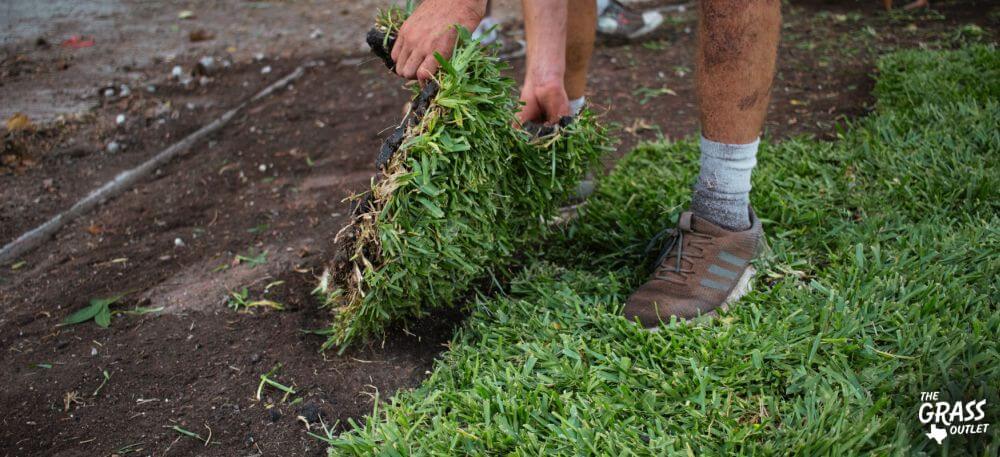
Pre-Installation: Soil Preparation
Proper soil preparation is mandatory to facilitate the development of root systems. The first step to take is to clear the sod placement area of old grass and debris and cover it with an optimal layer of topsoil.
Ensure the foundation is flat because any contours or low points lead to water pooling.
Soil Test
For a practical soil preparation approach, do a soil test. It will help to identify the soil type, showing which nutrients are lacking or if there are too many of them, with an interpretation of the results and recommendations for compost for lawn, fertilizer, or other amendments to enhance the soil. By following these preparations, you can boost sod to establish roots within the initial two weeks. More tips about sod installation you can read here.
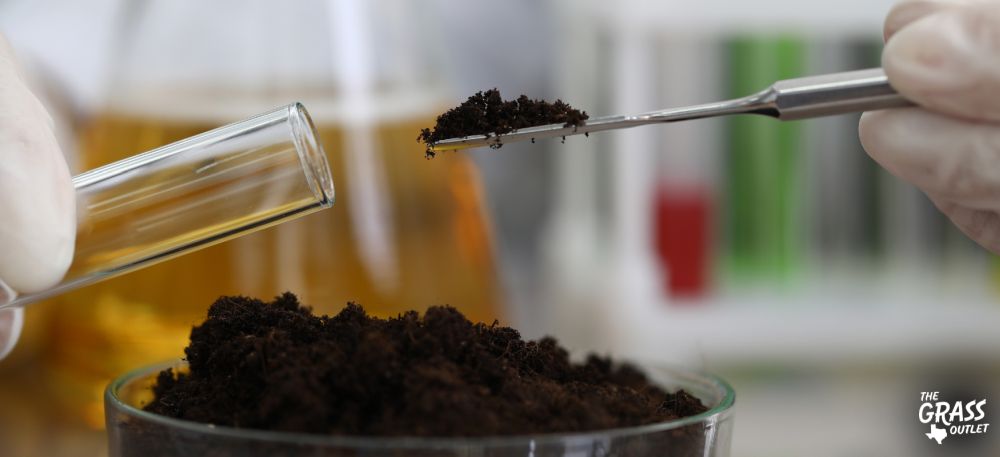
Optimal Time for Sod Installation
Although you can roll out and install sod throughout the year, it tends to perform better in warmer weather, with autumn being particularly favorable.
Autumn proves advantageous because the soil retains warmth, facilitating root growth, while the cool air minimizes stress on the roots, ensuring an adequate water supply to the grass.
Extensive watering is essential to the sod’s health, especially if it’s established in mid-summer.
The duration for sod to take root varies with the seasons. It can establish roots in five to 15 days during the summer, while rooting may take twice as long in winter.
Rooting Stages
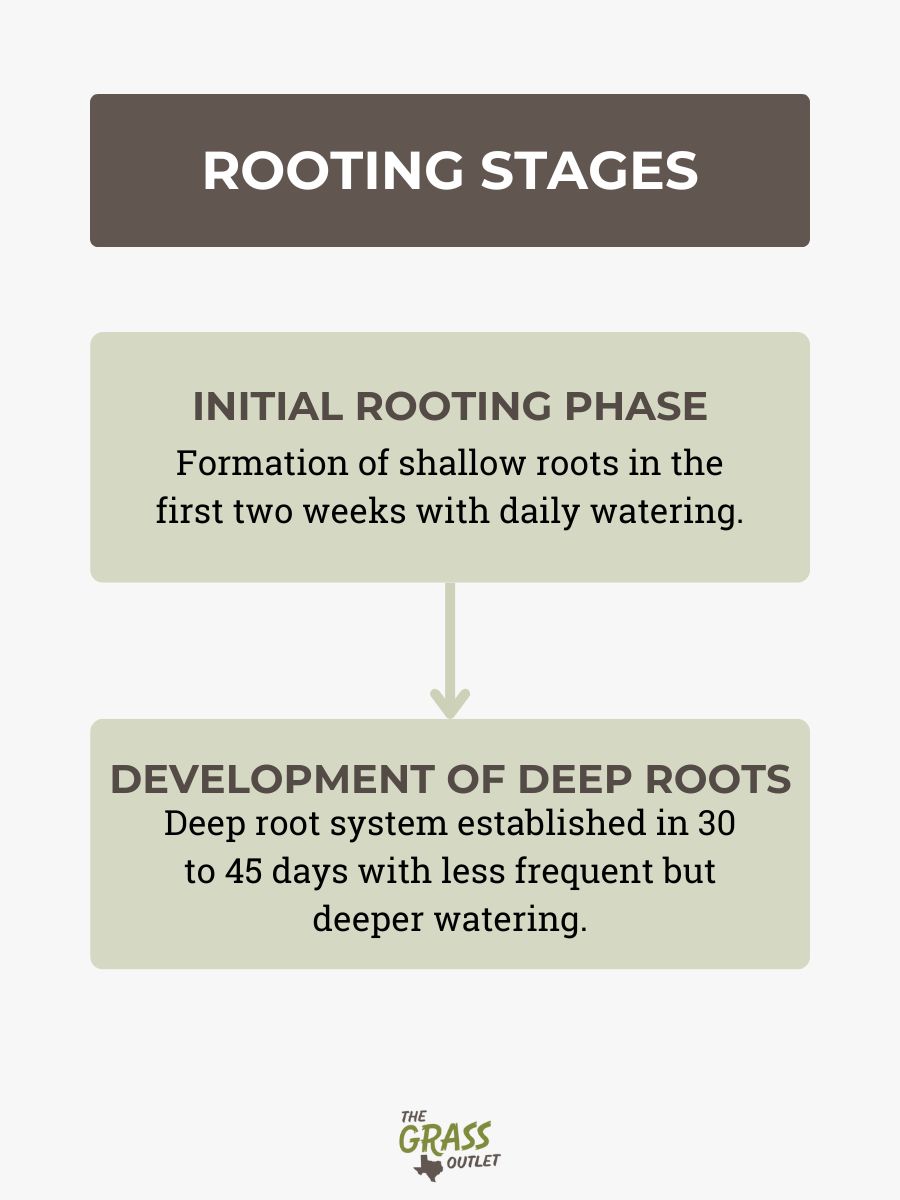
Once you lay sod, the rooting process occurs in two stages. Let’s delve into how this process works.
Initial Rooting Phase
Within the first two weeks, you can expect your newly laid sod to initiate the formation of a shallow root system. To ensure the healthy formation of these shallow roots, it is essential to commence watering immediately after laying the sod and continue this practice daily for the following week. Ensure to prevent the short roots from drying out. If it happens during the first week, it can significantly jeopardize the overall health of your new lawn.
Given the sensitivity of this stage, it is advisable to refrain from walking on the sod or mowing the lawn during this period.
Development of Deep Roots
Deep roots need more time to develop. When properly nurtured, you can expect a deep root system to be established in 30 to 45 days. Following the maturation of the shallow root systems, you can gradually reduce the frequency of turf watering. Providing ample water every other day encourages the roots to delve deeper in pursuit of moisture. Consequently, you should extend each watering session as the watering frequency decreases.
After the installation, the turf area is still not ready for outdoor activities for at least a few weeks. Excessive and premature use of the new sod may impede the development of roots.
How can you quickly check if a new sod is developed? Lift one corner of a sod piece slowly, and if you feel little or no resistance, the roots haven’t fully developed. Conversely, if lifting the sod requires effort, it shows a properly developed root system.
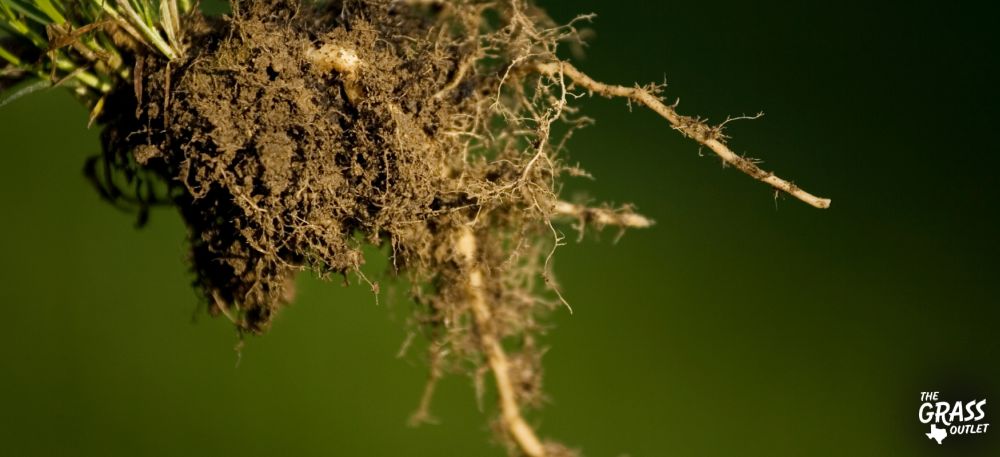
Maintenance and Care In the First Year
After the first six weeks, we recommend to extend the intervals between watering sessions. This approach helps the root system develop and facilitates access to the essential moisture and nutrients required for sustained vitality and expansion.
Each watering should provide just enough moisture to saturate the roots. As the first mowing date approaches, it is recommended to decrease the watering of the new sod. It allows the roots to take hold of the soil and be prepared for the initial mow.
You can mow the new lawn approximately two weeks after installation. However, it is crucial to be mindful of the delicate nature of the new sod’s root system, aiming to prevent any tearing before it achieves full establishment. Do double-check to be sure that the sod has developed its shallow root system and has at least 3 and a half inches of blade growth before initiating the mowing process. Remember to never remove too much growth in a single mowing.
Common Mistakes to Avoid for Healthy Rooting
Overwatering and underwatering
Proper watering your lawn is crucial to have healthy sod. Too much or too little water could damage your new lawn.
Try to avoid overwatering the sod. We can say that sod absorption capacities are limited since an excessive amount of water can create a conducive environment for fungus beneath the roots, leading to the potential failure of your new sod.
Insufficient watering, on the other hand, can result in the demise of roots. Be sure that water covers your entire lawn, recognizing that areas near buildings or asphalt may dry out more rapidly due to reflected heat. Those areas also may need additional water.
Do watering during the early morning hours. Watering in the afternoon can lead to significant moisture loss through evaporation and wind, while evening watering may encourage mold growth. Early morning watering allows the grass to dry throughout the day, preventing the onset of detrimental diseases and deterring insects.
Incorrect mowing practices
Another common mistake in lawn maintenance is trimming the grass excessively short. If you cut the grass too closely, you can disable surface area for photosynthesis. It leads to depriving your lawn of essential nutrients and slows growth. The general recommendation is to mow frequently enough to maintain the desired height within the recommended range while only removing one-third of the grass length during each mowing session.
Fertilization errors
The new sod care extends beyond just adequate watering and mowing; it also encompasses providing additional nourishment to the roots. Fertilizer plays a vital role in promoting the establishment of your new sod’s roots, rendering it more resilient against diseases and insects.
It is recommended to apply fertilizer approximately five weeks after the sod installation. The choice of fertilizer depends on the specific sod variety installed and the soil characteristics of your property. Always follow the manufacturer’s guidelines when applying fertilizer, and be careful, as too much fertilizer can burn the grass, causing it to turn brown.
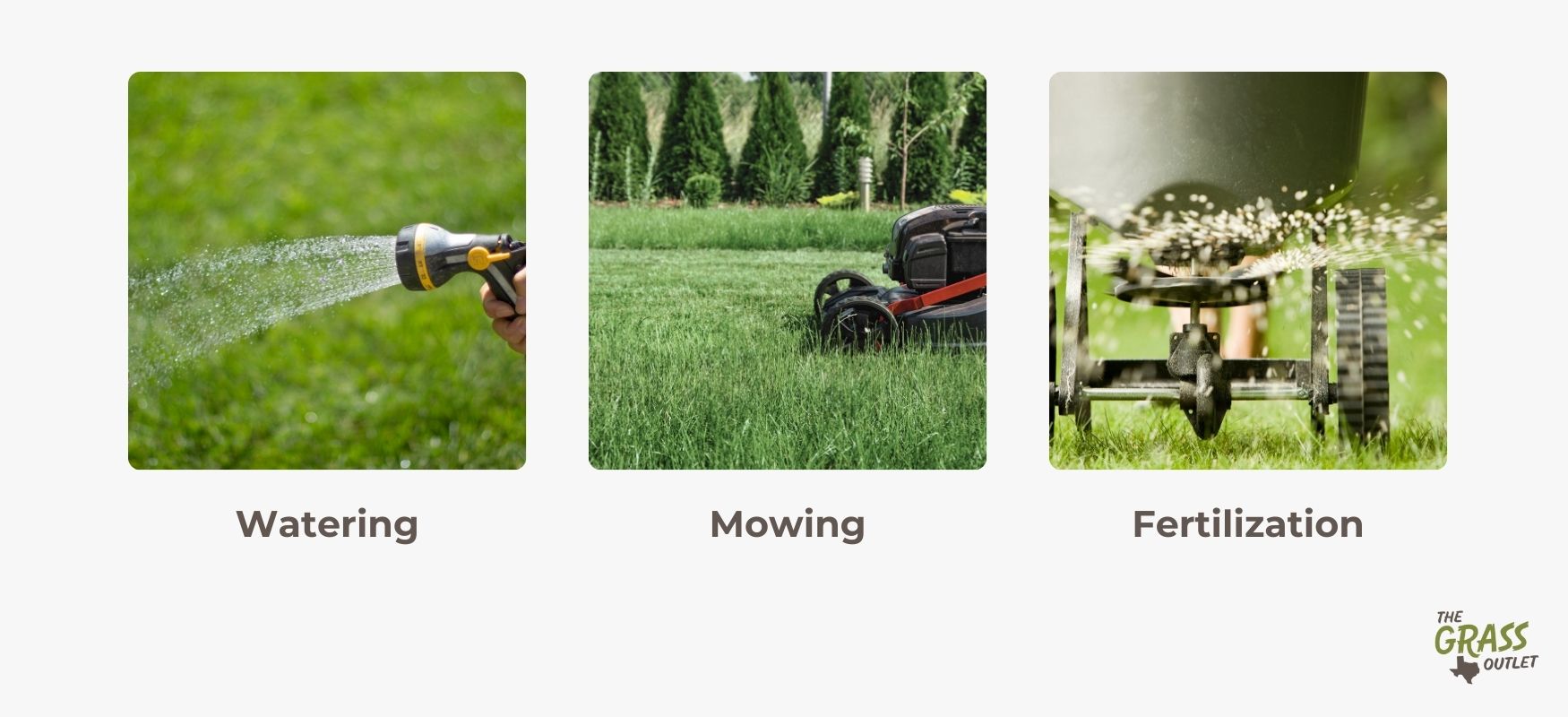
Factors That May Hinder Root Development
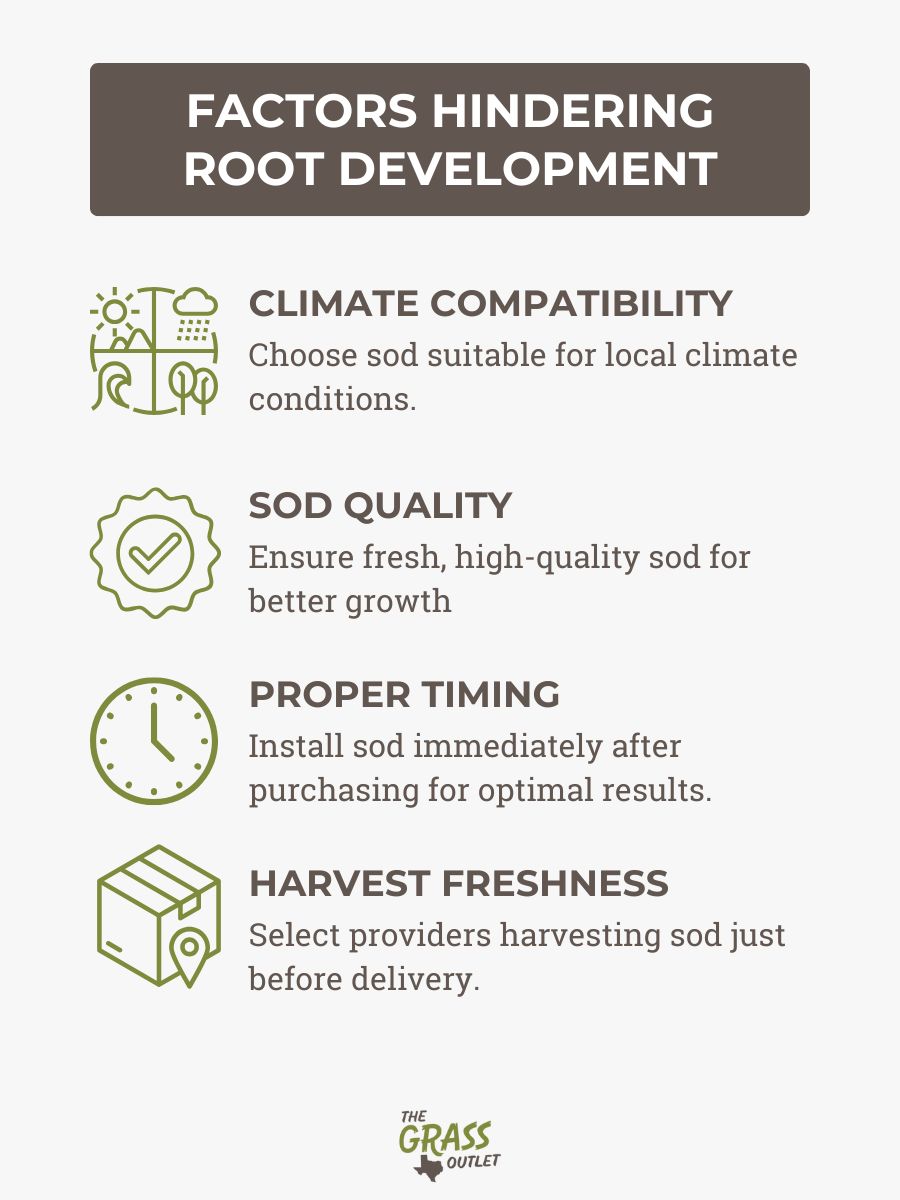
Numerous factors play a significant role in influencing the pace of root growth and development. In addition to some common errors, it’s essential to consider a few more aspects.
Certain grass varieties thrive only under specific climatic conditions. Consequently, if you don’t choose the proper sod type for the local climate and yard conditions, it can prolong the root development for that particular sod type.
The quality of sod also holds significant importance. To achieve optimal results, ensure that your sod provider, as The Grass Outlet does, harvests grass fresh the day before the scheduled delivery immediately after receiving orders. Harvesting at the right time guarantees that you will get fresh and higher-quality sod after you make an order. Therefore, it will foster robust root development. It’s also crucial to note that once purchased, you should install the sod promptly.
Conclusion
Establishing sod for a new lawn brings some challenges and can cause a bit of stress. Understanding the appropriate timing for watering, mowing, and fostering a robust root system is crucial for the process and a healthy, beautiful lawn.
This guide provides you with comprehensive information to take care of your recently laid sod lawn. For more in-depth assistance or if you require professional guidance, feel free to contact The Grass Outlet.


